List of stumbling blocks in Kulmbach
The list of the stumbling blocks in Kulmbach contains the stumbling blocks that the Cologne artist Gunter Demnig in Kulmbach were laid. Stumbling blocks remind of the fate of the people who were murdered, deported, expelled or driven to suicide by the National Socialists . As a rule, they are in front of the victim's last self-chosen place of residence.
The relocations in Kulmbach took place in 2012 and 2014.
Jews in Kulmbach
In 1372 the burgrave Friedrich V declared the scholar Meir zu Peyerreut to be a regional rabbi for the Jewish communities of Bayreuth, Hof and Kulmbach. From 173 on, the Kulmbach Jews were given tax privileges and letters of protection and a Jewish court was set up, which met in front of the synagogue on Judenplatz. The Jews residing in Kulmbach probably lived on Judenplatz, or in Judengasse (this has been called Waaggasse since 1845). They earned their living by trading in money. From 1444 the Jewish community no longer existed; individual families lived in here over and over again over the next few centuries. The city council was strictly against Jews, this restrictive policy was maintained for centuries. From the 19th century, Jewish traders were allowed to visit the city for business purposes during the day. With the Bavarian Edict of Jews of 1813 , the legal equality of Jews began, a few families also settled in Kulmbach, so in 1899 there were just five Jewish families with a total of 27 family members. They applied to the Bayreuth government for recognition as an Israelite religious community, which was granted in 1903. It was semi-autonomous and was under the district rabbinate of Burgkunstadt, the dead were still buried in the Ebnether cemetery of Burgkunstadt. Anti-Semitic agitation arose as soon as the Jewish community was founded. A prayer room was rented in the “Hotel Goldener Hirsch”, later the services were held in the “Cafe Beyerlein” and then until 1933 in the “Krone” inn. After 1933, after the National Socialists came to power, the services were held in Franz Weiss' house . From 1914, after the death of the district rabbi Dr. Ezekiel Goitein, the community Kulmbach belonged to the district rabbinate of Bayreuth, funerals continued to take place in Burgkunstadt.
Towards the end of the 1920s, the NSDAP gained significant influence, and Kulmbach became one of the strongholds in Bavaria with the largest number of members. In 1930 there were still 43 people of Jewish faith living in Kulmbach, but the number fell rapidly due to anti-Semitism, boycotts and persecution. In 1938 there were only 16 Jews left in Kulmbach, and during the November pogroms the five Jewish heads of household were appointed to the Fronfeste . Karl Strauss had previously managed to save the Torah scrolls and bring them to Burgkunstadt. After all, he was one of the first Jewish citizens of Kulmbach to fall victim to the Nazi justice system: sentenced to eight years in prison in 1938 for racial disgrace , he was later deported to Auschwitz and murdered. On April 25, 1942, the Flörsheim and Davidsohn families were deported to Eastern Europe, so that Kulmbach was "clean of Jews".
After the liberation from National Socialism in April 1945, a Jewish community of 100 displaced persons, most of whom came from Eastern Europe, briefly formed again. Some of them were accommodated in the apartments and houses of those polluted by Nazi. A Jewish community center (the Parkschenke, today Hotel Ertl) was inaugurated in August 1946. After the establishment of the State of Israel , most of the Jewish DPs left Kulmbach and went to Israel. On November 15, 1948, the few remaining were officially adopted by the then mayor Georg Hagen in the presence of a representative of the Jewish Central Committee, Nathan Spitzer.
Stumbling blocks
| Stumbling block | inscription | Location | Name, life |
|---|---|---|---|
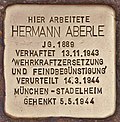
|
HERMANN ABERLE JG WORKED HERE . 1889 ARRESTED 11/13/1943 'DEPLOYMENT OF ARMY FORCE AND ENEMY FAVORING' CONVINCED 03/14/1944 MUNICH-STADELHEIM HANGED 05/05/1944 |
Langgasse 7 |
Hermann Aberle was born in 1889. Aberle was a radio dealer, he ran his business from Langgasse and had at least one son, Ludwig. Aberle was an opponent of Hitler and joked about Hitler in his local "Café Beyerlein" as well as with customers to whom he delivered radios. He was denounced to the district leadership of the NSDAP Rugendorf because of "insulting the Führer" and because of the suspicion of making the "people's receivers" suitable for listening to the "enemy broadcasters". On November 13, 1943, he was arrested by the Gestapo and transferred to the People's Court. On March 14, 1944, he was convicted of "decomposing military strength and favoring the enemy". On May 5, 1944, Hermann Aberle was hanged in Munich-Stadelheim. His son fought in vain to the end with petitions against his father's death.
A street in Kulmbach, Hermann-Aberle-Strasse, was named after him. |
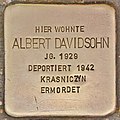
|
ALBERT DAVIDSOHN JG LIVED HERE . 1,929 deported in 1942 Krasniczyn MURDERED |
Holzmarkt 12 |
Albert Davidsohn was born on April 13, 1929 in Kulmbach. His parents were Berta and Georg Davidsohn. He had a twin sister, Ingeborg, and another sister, Hildegard (born 1926). The family had a haberdashery and toy shop. After the National Socialists came to power, his father was deprived of his pension of 150 Reichsmarks through the enactment of the law to restore the civil service . The business on Holzmarkt was terminated, as was the apartment on Langgasse. They had to move to a barracks in Priemershof, and they tried to continue their business in Spitalgasse. On November 10, 1938, there was harassment in the school. Albert was exposed to the mockery and laughter of the other students by the headmaster and is presented as a "Jew boy". Albert's family tried to get a guarantee to emigrate to Australia, but they couldn't. On April 25, 1942, Albert was arrested by the Gestapo with his parents and siblings. She broke into the barrack early in the morning and took the family to the freight yard. From there they were deported to Kraśniczyn . In June 1942 the camp was closed, Albert Davidsohn and his family were taken to one of the extermination camps in the area and murdered there. |

|
BERTA DAVIDSOHN GEB. LIVED HERE MARCUS JG. DEPORTED 1893 1942 KRASNICZYN MURDERED |
Holzmarkt 12 |
Berta Davidsohn , née Marcus, was born on December 14, 1893 in Burgkunstadt . Her father was Bernhard Marcus, who ran a haberdashery and toy shop at Holzmarkt 12. Berta Marcus married Georg Davidsohn in 1925, a city employee from Berlin. The couple had three children: Hildegard, born in 1926 and the twins Albert and Ingeborg, born in 1929. The Davidsohns ran the toy shop together with Bernhard Marcus. After the National Socialists came to power, Berta Davidsohn's husband was stripped of his pension; in 1934 they were given notice of their business, as was their apartment in Langgasse, and they had to move into a barracks in Priemershof, together with the Flörsheim couple. The family tries to get a guarantee to be able to emigrate to Australia. You fail. At dawn on April 25, 1942, a Gestapo detachment broke into the barrack and arrested Berta Davidsohn and her family. They are taken to the freight yard and from there deported by train to Kraśniczyn. The camp was disbanded in June 1942. Berta Davidsohn and her family were transferred to an extermination camp nearby and murdered there. |

|
GEORG DAVIDSOHN JG LIVED HERE . DEPORTED IN 1888, 1942 MURDERED KRASNICZYN |
Holzmarkt 12 |
Georg Davidsohn was born on April 11, 1888 in Schrimm , then Prussia . He had been a municipal employee in Berlin. He married Berta, nee Marcus. The couple had 3 children: Hildegard, born in 1926 and the twins Albert and Ingeborg, born in 1929. The family ran a haberdashery and toy shop at Holzmarkt 12. Georg Davidsohn was considered a social worker, and he kept buying goods for war widows and large families in the butcher's shop. Davidsohn was arrested for the first time in 1933, and deportation to the Dachau concentration camp was prevented by an intervention by the Kulmbach police chief Hans Schiffner. His pension of 150 Reichsmark was canceled after the law to restore the civil service was passed . In 1934, the family's business on Holzmarkt was terminated, as was the apartment on Langgasse, they had to move into a barrack in Priemershof near Metzdorf , where they had to live with the Flörsheim couple. They are now trying to run the business elsewhere, in Spitalgasse. But everyone who bought from them was blacklisted. During the Reichspogromnacht Davidsohn was taken into "protective custody". The family tried to obtain an exit permit through a Swiss guarantee and thus to flee to Australia. They didn't succeed. At dawn on April 25, 1942, a Gestapo detachment broke into the barrack and arrested Georg Davidsohn and his family, as did the Flörsheim couple. They were taken to the freight yard and from there deported by train to Kraśniczyn. The camp was disbanded in June 1942. Georg Davidsohn and his family were transferred to an extermination camp nearby and murdered there. |
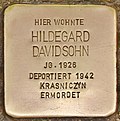
|
HILDEGARD DAVIDSOHN JG LIVED HERE . DEPORTED 1926 1942 KRASNICZYN MURDERED |
Holzmarkt 12 |
Hildegard Davidsohn was born on September 30, 1926 in Kulmbach. Her parents were Berta and Georg Davidsohn. She had 2 siblings, the twins Ingeborg and Albert, who were born in 1929. Her family ran a haberdashery and toy shop. After the National Socialists came to power, life became increasingly difficult for the family, their father was arrested in 1933 and again during the Reichspogromnacht, their brother was humiliated in school, their parents' business had to move, their apartment was given notice and the family had to go along with them the couple Flörsheim live in a barrack. The attempt to leave the country and to emigrate to Australia failed. At dawn on April 25, 1942, a Gestapo detachment broke into the barrack and arrested Hildegard Davidsohn and her family, as did the Flörsheim couple. They were taken to the freight yard and from there deported by train to Kraśniczyn. The camp was disbanded in June 1942. Hildegard Davidsohn and her family were transferred to an extermination camp nearby and murdered there. |
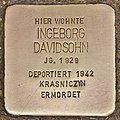
|
INGEBORG DAVIDSOHN JG LIVED HERE . 1,929 deported in 1942 Krasniczyn MURDERED |
Holzmarkt 12 |
Ingeborg Davidsohn was born on April 13, 1929 in Kulmbach. Her parents were Berta and Georg Davidsohn. She had 2 siblings, Hildegard, who was born in 1926, and her twin brother Albert. Her family ran a haberdashery and toy shop. After the National Socialists came to power, life became increasingly difficult for the family, their father was arrested in 1933 and again during the Reichspogromnacht, their brother was humiliated in school, their parents' business had to move, their apartment was given notice and the family had to go along with them the couple Flörsheim live in a barrack. The attempt to leave the country and to emigrate to Australia failed. At dawn on April 25, 1942, a Gestapo detachment broke into the barrack and arrested Ingeborg Davidsohn and her family, as well as the Flörsheim couple. They were taken to the freight yard and from there deported by train to Kraśniczyn. The camp was disbanded in June 1942. Ingeborg Davidsohn and her family were transferred to an extermination camp nearby and murdered there. |

|
HERE LIVED
NATHAN FLÖRSHEIM JG. DEPORTED 1886 1942 KRASNICZYN MURDERED |
Langgasse 12 |
Nathan Flörsheim was born on December 20, 1886 in Kulmbach. His father was Moses Flörsheim, he had a brother named Bruno. On January 21, 1913, Nathan Flörsheim married Selma, nee Stiefel, in Hammelburg . The couple had three children: Vera (born 1914), Ilse (born 1916) and Herbert (born 1920). Since 1913 Flörsheim worked as a cattle dealer. He was arrested during the November pogroms. The apartment in Langgasse was given notice to them, they had to move the Davidsohns into a barrack in Priemershof with their neighbors. They were driven to ruin by the Nazi farmers' association through defamation, so it is claimed that Flörsheim had "mangy" or "tuberculous cattle". His father died in 1935; he was the last Jew from Kulmbach to be buried in the Jewish cemetery in Burgkunstadt. The three children of the Flörsheims manage to escape and emigrate to the USA. At dawn on April 25, 1942, a Gestapo detachment broke into the barrack and arrested Nathan Flörsheim and his wife, as well as the Davidsohn family. They were taken to the freight yard and from there deported by train to Kraśniczyn. Nathan Flörsheim and his wife did not survive the Shoah . |
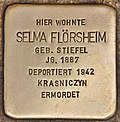
|
HERE LIVED
SELMA FLÖRSHEIM GEB.STIEFEL JG. 1,887 deported in 1942 Krasniczyn MURDERED |
Langgasse 12 |
Selma Flörsheim , nee Stiefel, was born on March 25th, 1887 in Hammelburg. In 1913 she married the cattle dealer Nathan Flörsheim and moved to live with him in Kulmbach. The couple had three children: Vera (born 1914), Ilse (born 1916) and Herbert (born 1920). After the National Socialists came to power, the family was subjected to various harassments. Selma Flörsheim's husband was taken into "protective custody" during the November pogroms, the NS-Baunerverband drove them to ruin by defamation, their apartment was terminated and they had to move into a barrack with neighbors, the Davidsohn family. Their three children were able to get to safety and they emigrated to the USA. At dawn on April 25, 1942, a Gestapo detachment broke into the barrack and arrested Selma Flörsheim and her husband, as well as the Davidsohn family. They were taken to the freight yard and from there deported by train to Kraśniczyn. Selma Flörsheim and her husband did not survive the Shoah. |
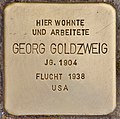
|
HERE LIVED
AND WORKED GEORG GOLD BRANCH JG. 1904 ESCAPED 1938 USA |
Spitalgasse 2 |
Georg Goldzweig , later George Goldzweig, was born on June 19, 1904 in Berlin. He met Ruth Weiß in Pomerania , they married in 1931 and they moved to Kulmbach. Goldzweig became an authorized signatory in the fashion business of his father-in-law Franz Weiß. Their son Manfred was born in 1933. In August 1937 they applied to leave the USA, their assets were confiscated and in March 1938 they were allowed to leave the country. On July 27, 1938, Georg Goldzweig was able to emigrate with his wife and son by ship from Hamburg to the USA. There they lived in New York. From the end of the 1950s they visited Kulmbach regularly, especially the former police chief, Heinz Schiffner, who had helped them and other Jews during the Nazi era. George Goldzweig died on October 17, 2002 |
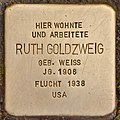
|
HERE LIVED
AND WORKED RUTH GOLD BRANCH GEB. WHITE JG. 1906 ESCAPE 1938 USA |
Spitalgasse 2 |
Ruth Goldzweig , nee Weiß, was born on December 12, 1906. Her parents were Franz and Henriette Weiß. Her father was the owner of a fashion store. She had a brother, Siegfried (born 1905). Ruth Weiß got to know Georg Goldzweig, who came from Berlin, in Pomerania, they both married in 1931 and he joined her father's business as an authorized signatory. In 1933 their son Manfred was born. The family decided to flee, in 1937 they made an application to leave the USA, in 1938, after confiscating their property, this was approved and they left Germany by ship from Hamburg. They settled in New York, and from the late 1950s they kept coming back to Kulmbach. Ruth Goldzweig died on August 26, 2000.
Her father fled to London and was killed there in a bomb attack, her brother was also able to save himself by fleeing to the USA. |
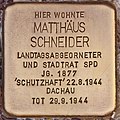
|
HERE LIVED
MATTHEW SCHNEIDER LANDTAG DEPUTY AND CITY COUNCIL SPD JG. 1877 'PROTECTIVE' 08/22/1944 DACHAU DEAD 09/29/1944 |
Hagleite 24 |
Matthäus Schneider was born on November 15, 1877 in Kasendorf, the son of a day laborer. He came to Kulmbach as a worker for the Pertsch brewery. He became politically active, from 1910 he was chairman of the SPD Kulmbach, in 1919 he became a city councilor and in 1919/1920 he was a member of the Bavarian state parliament for half a year. He was also local editor at theBayreuth public tribune . In March 1933 he was taken into "protective custody" for several months on charges of "usury", after which he was under house arrest for a year. On August 22, 1944, hewas arrested againas part of the Grid Action and a few days later, seriously ill with asthma, was deported to the Dachau concentration camp , where he was imprisoned from August 30. Contrary to the warning of a fellow inmate, Schneider reports sick ("Don't be sick, Matthis, you can't get out!"). Matthäus Schneider lost his life in Dachau on September 29, 1944. A street in Kulmbach is named after him. He had at least one child, and his descendants still live in Kulmbach today. |

|
KARL STRAUSS JG LIVED HERE . 1873 deported MURDERED IN AUSCHWITZ |
Kronacher Strasse 3 |
Karl Strauss was born on May 5, 1873 in Hollfeld . He was a cattle dealer and married to Frieda. The couple had their son Gottfried, born in 1907. During the First World War , Karl Strauss fought as a volunteer at the front. After the National Socialists came to power, his sales license was revoked. On November 8, 1938, he rescued the Torah scrolls and smuggled them to Bamberg. During the pogroms he was taken into "protective custody" and released on November 19, 1938. During his arrest, his home was searched, and sacred objects from the prayer room were found and confiscated. Shortly thereafter, the widower is accused of racial disgrace, he is said to have had a relationship with a gentile woman, his landlady. She was driven through Kulmbach on November 13, 1938 with a shield around her neck, accompanied by an SA music corps, after which she was also taken into "protective custody" for six weeks. Strauss was charged with continuing economic offense after his arrest, but an audit of his bookkeeping showed nothing. He was reported to the Bayreuth public prosecutor's office for "the continued crime of racial disgrace". On March 15, 1939, he was found guilty and sentenced to eight years in prison. He was deported to Auschwitz. Karl Strauss did not survive the Shoah .
His son Gottfried was able to escape with his wife Irene, they emigrated to Australia. His daughter Dagmar published a book with her family history. |
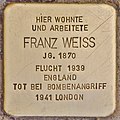
|
FRANZ WEISS JG LIVED AND WORKED HERE . 1870 ESCAPE 1939 ENGLAND DEAD IN BOMB ATTACK 1941 LONDON |
Spitalgasse 2 |
Franz Weiß was born on July 10, 1870 in Debrecen . In 1902 the trained tailor came to Kulmbach and became a co-founder of the local Jewish community. He worked in D. Winterstein's fashion store. In 1904 he married Henriette, née Gollanscher. With her he had two children: Siegfried (born 1905) and Ruth (born 1906). In 1910 he took over the Winterstein fashion business and expanded it. in the First World War , White served as a volunteer. His wife Henriette died in 1930. In the following year his daughter Ruth married Georg Goldzweig, who came from Berlin and became an authorized signatory in his business. From 1934 religious celebrations took place in his house, Weiss wanted to promote the cohesion of the community. In 1938 he fled the harassment of the Nazis to London. Franz Weiß was killed by German bombs on February 16, 1941 .
His grave is in London. Both children were also able to get to safety through emigration. They emigrated to the USA. |
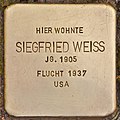
|
SIEGFRIED WEISS JG LIVED HERE . 1905 ESCAPE 1937 USA |
Spitalgasse 2 |
Siegfried Weiß was born on August 16, 1905 to Franz and Henriette Weiß. He had a younger sister, Ruth, born in 1906. His father was the owner of a fashion shop and enabled him to attend the Royal High School, for which school fees had to be paid. In 1918 Henriette Weiß helped her son get a bar mitzvah . There weren't enough minyan men because the war meant that the men were still called up. She turned to the commandant of the Plassenburg prison camp , who briefly released French and Russian officers of the Jewish faith. Siegfried Weiß completed an apprenticeship as a tailor and moved to Augsburg in 1927 , where he became head of accounting in a textile company. He got to know Kunigunde Brodmann, they fell in love. After Hitler came to power, he left Brodmann to protect them. He moved several times in order to avoid being attacked by the Nazis. He lived in Nuremberg, Munich and Mannheim. Eventually he met Helen Golomb, a Jew from the USA. She entered into a fictitious marriage with him and took her to New York in 1937. He became an American citizen and served in the US Army during World War II . After the war he worked again for a textile company and was a cloth buyer in England. In 1958 he returned to Kulmbach and went in search of his childhood sweetheart Gundi Brodmann. He found her in Kötzting . In 1961, Weiss divorced his American wife, and one week later Brodmann and Weiss married. They settled in Augsburg. He became commercial operations manager for Hettlage . Siegfried Weiß died on February 24, 1989. He was buried in the Jewish cemetery in Bamberg, in his mother's grave.
His mother died in 1930. His father emigrated to London and was killed there in 1941 by German bombs. His sister Ruth and her husband also emigrated to the USA and survived. |
Memorial stone
| Memorial stone | inscription | Location | ||
|---|---|---|---|---|
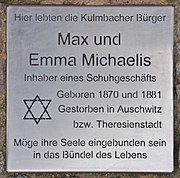
|
Here lived the citizens of Kulmbach,
Max and Emma Michaelis. Owners of a shoe shop. Born in 1870 and 1881. Died in Auschwitz and Theresienstadt, respectively. May your soul be integrated into the bundle of life |
Kressenstein 12 |
||
|
||||
Laying data
Even before the first original stumbling blocks were laid in Kulmbach, the memorial stone for the shoe retailer couple Emma and Max and Michaelis was laid at Kressenstein 12 on May 9, 2012. This stone is significantly larger than the stumbling blocks. Wolfgang Schoberth gave a memorial address. Another memorial plaque for another family member, Max Michaelis of the same name, was laid in Bochum. On July 20 and 23, 2012, Gunter Demnig laid fourteen stumbling blocks for other family members in Berlin.
The stumbling blocks of Kulmbach were laid by Gunter Demnig personally on the following days:
- November 11, 2012: Hagleite 24, Holzmarkt 12, Langgasse 7 and 12
- May 5, 2014: Spitalgasse 2
Award
The Evangelical Lutheran Church in Bavaria awarded the upper school students of the Caspar-Vischer-Gymnasium in Kulmbach with the Wilhelm-Pechmann-Preis 2013. Wilhelm Freiherr von Pechmann (1859–1948) was director of the Bayerische Handelsbank in Munich and an important representative of the Evangelical Lutheran Church. The award was presented on November 7, 2013 in the St. Mark's Church in Munich . As part of a seminar led by their teacher Christian Kramer, the pupils researched the fate of the persecuted families and campaigned for the first ten stumbling blocks to be laid in Kulmbach.
Web links
- Gunter Demnig: Stolpersteine - website of the project
Individual evidence
- ↑ a b c alemannia-judaica.de: Kulmbach , accessed on March 8, 2020
- ↑ From the history of the Jewish communities in the German-speaking area: Kulmbach (Upper Franconia / Bavaria ), accessed on March 17, 2020
- ↑ a b c d e f g h i j inFranken.de: Pupils set "stumbling blocks" to commemorate , accessed on March 4, 2020
- ↑ a b c d e f g h i j A city derailed , accessed on March 5, 2020
- ↑ a b c d e inFranken.de: Friendship to the end , accessed on March 4, 2020
- ↑ inFranken.de: A clearer without a moral club , accessed on March 4, 2020
- ↑ Commemorative Book Victims of the Persecution of Jews under the National Socialist Tyranny in Germany 1933–1945: Davidsohn, Albert , accessed on March 4, 2020
- ^ Commemorative book victims of the persecution of Jews under the Nazi tyranny in Germany 1933–1945: Davidsohn, Berta , accessed on March 4, 2020
- ↑ a b c inFranken.de: A fellow traveler with manly courage: the story of a Kulmbach policeman , accessed on March 5, 2020
- ^ Commemorative book victims of the persecution of Jews under the Nazi tyranny in Germany 1933–1945: Davidsohn, Georg , accessed on March 5, 2020
- ^ Commemorative book victims of the persecution of Jews under the Nazi tyranny in Germany 1933–1945: Davidsohn, Hildegard , accessed on March 5, 2020
- ^ Commemorative book victims of the persecution of Jews under the National Socialist tyranny in Germany 1933–1945: Davidsohn, Ingeborg , accessed on March 5, 2020
- ^ Jews in Lich, Birklar, Langsdorf, Muschenheim and Ettingshausen, History Association for Butzbach and the Surrounding Area , 2010, ISBN 3-9809778-6-2 , p. 162
- ^ Commemorative book victims of the persecution of Jews under the National Socialist tyranny in Germany 1933–1945: Flörsheim, Nathan , accessed on March 6, 2020
- ↑ Wolfgang Schobert: History of Judaism in Kulmbach. In: Yearbook of the Colloquium Historicum Wirsbergense, 18 (1991/92), p. 85
- ^ Commemorative book victims of the persecution of Jews under the Nazi tyranny in Germany 1933–1945: Flörsheim, Selma , accessed on March 6, 2020
- ↑ a b c d inFranken.de: Stumbling blocks against forgetting , accessed on March 7, 2020
- ↑ a b c d e inFranken.de: Faces of Jewish Citizens , accessed on March 7, 2020
- ↑ George Goldzweig - Social Security Death Index , accessed March 7, 2020
- ^ Ruth Goldzweig - Social Security Death Index , accessed March 7, 2020
- ↑ Kasendorf , accessed on March 8, 2020
- ^ House of Bavarian History: Matthäus Schneider , accessed on March 8, 2020
- ^ Resistance 1933-1946 , accessed March 8, 2020
- ↑ Infranken.de: In Niederndobrach the old times are coming back to life , accessed on March 8, 2020
- ↑ Commemorative Book Victims of the Persecution of Jews under the National Socialist Tyranny in Germany 1933–1945: Strauss, Karl , accessed on March 8, 2020
- ↑ Dagmar Strauss: Late Journey: A Memoir, BookBaby 2014, ISBN 978-1-4835-2206-7
- ↑ a b inFranken.de: Love knows no displacement , accessed on March 9, 2020
- ^ Commemorative book victims of the persecution of Jews under the National Socialist tyranny in Germany 1933–1945: Michaelis, Emma Selma , accessed on March 10, 2020
- ↑ a b inFranken.de: Harsdorf historian gives Nazi victims their names back , accessed on March 11, 2020
- ↑ a b From “Masel Tov” to the extermination camp , accessed on March 11, 2020
- ^ Commemorative book victims of the persecution of Jews under the Nazi tyranny in Germany 1933–1945: Lax, Emma Regina Regine , accessed on March 10, 2020
- ^ Commemorative book victims of the persecution of Jews under the Nazi tyranny in Germany 1933–1945: Michaelis, Max , accessed on March 15, 2020
- ↑ blickpunkt-verlag.de: Schoolchildren researching Jewish fates , accessed on March 16, 2020
- ↑ a b Stumbling block laying in Berlin , accessed on March 15, 2020.
- ↑ WAZ : Holocaust victim Max Michaelis receives a commemorative plaque in Bochum , January 30, 2011, accessed on March 16, 2020
- ↑ inFranken.de: Landeskirche honors Stolperstein project , October 17, 2013, accessed on March 16, 2020

